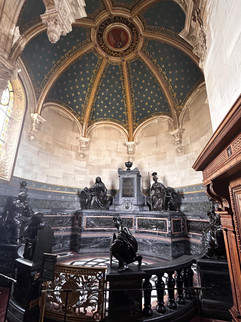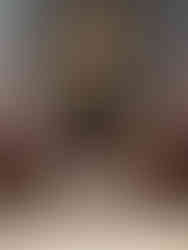Château de Chantilly - Crème de la Cream
- danrn4
- Apr 5
- 6 min read

The competitive opulence of the royal court of France was probably unmatched during the reign of Louis XIV, the Sun King, whose own extravagance pitted other royal family members and nobles against each other to vie for his the favour. One can hardly blame the general populace’s disdain and eventual revolt against the monarchy for the class division, tax burden, and disconnect from reality. Of course it was not Louis XIV’s price to pay but, rather, his grandson who would loose his head two generations later. Château de Chantilly was built by the Prince of Condé, a brilliant military general and “Prince of the Blood” (cousin to Louis XIV), whose masterpiece rivaled the beauty of Versailles and spawned a bit of jealousy of the king. If you have not seen the 2000 movie Vatel, it is a beautiful historical drama that captures the essence of the French court, decadence of the period, and fictionalized dynamics when King Louis XIV and the court visit Chantilly. It also provides a story as to how Chantilly cream may have been invented.
The Château de Chantilly is located approximately a 30-minute train ride to the north-northeast of Paris that is quite easy to navigate from Gare du Nord and gives one a sense of the immediate countryside. As it is Spring, there the buds on the trees were popping out and some of the fields were already showing signs of winter wheat sprouting up. In some ways, the topography resembles that of places in Canada - no huge vast fields of the prairies, though, but rather what you might see along the St. Lawrence River, the Ottawa valley, or interior parts of BC. Of course, a major difference is no accumulation of snow here. One of the things I really enjoy with these kinds of trips is the relaxation of watching the countryside glide past and being lulled by the gentle sway and clickity-clack of the coach. Our arrival was to the very quaint and sleepy town of Chantilly with a downtown core of two main streets, completely walkable and easy to find the château from. We were blessed with a very temperate day with light cloud and some sun making for a lovely jaunt along some well-groomed paths with stands of oak lining the boulevards and pathways.
Approaching from the Great Stables, which are imposing structures on their own, the scale of the estate and château is both immense and awe-inspiring. The sheer size of the buildings and architectural features gives a sense of the monetary investment but also some of the innovations that were used to reclaim swamp lands and provide hydraulic power for the fountains…moats to create drainage and playing with water tables to move water. I should imagine that closer to Summer, when the greenery is in full swing, the gardens and area surrounding the château would be spectacular…and crowded. But with Vatel already in my mind’s eye, I easily filled in the missing flora and flowing fountains when looking out across the canals and the grounds housing the paths to hidden pavilions.
The foundation of the château is a granite base that was kind of an island and, when they carved out the moat around where the structure was located, many of these stones were shaped and used in the structure of the château and other buildings. A grand canal was created as part of the grounds feature but also part of a waterway to ferry goods to the château as it connects to a system of small rivers. Although originally swampy in the immediate vicinity, the surrounding land are some of the most fertile in France; draining the swamps added more arable land and the associated moat offered protection and security to the château…well, at least up until the Revolution occurred when the whole place was razed to the ground. In comparison to Versailles, the Château de Chantilly is quite modest but very well-designed with exquisite furnishings and finishings in each room.
One feature common to many ancient castles and palaces is a chapel or, in some cases, a full on church. Chantilly has a quaint little chapel in keeping with the scale of the château that was pretty Spartan compared to most other religious houses and was quite prominent as an exterior wall of the château. The Catholic Church was a central spiritual and political force within France, as it was in many countries but there was always a tension in whose power was the highest - the divine right of kings versus the Pope and God. Often a cardinal or two played a prominent role in the court and government, such as Richelieu and Mazarin, sometimes in quite powerful administrative positions. I am not sure to what extent religion played a part for the Condé branch of the Bourbon line that had dabbled in Protestantism as Huguenots, but I surmise from the relative simplicity of the church that it might not have been that prominent. Ironically, unlike many of the other royal establishments and venues of the time, there was much less depiction of scantily clad women and sexualized nudes at Chantilly. I am not that much of a prude, but I have always found the paradox of religion and modesty in contrast to some of the less than modest sculptures and paintings somewhat weird. But then, although nominally committed to the Church, many of the royals were big into adultery and pretty much absolved of their indulgence of the deadly sins.
If I had to pick a phrase to describe the Château de Chantilly, I would say “simple yet elegant” might be appropriate - I say this in comparison to Versailles and other sites that go over the top in cluttering the visual senses. Yes, the château has a varied range of granites, marbles, woods (lots of oak), and other materials but I found there was more of an intentional use of clean lines and contrasts (e.g., deep reds and greens) that really created the beauty. The modern château we see is not the same as it was at the time of the revolution, since the original was totally destroyed and rebuilt, temporarily abandoned, and then refurbished again. Much of the furnishings are not the originals to fully know what it was like at the time of Louis XIV; however, one can well imagine the spirit of competition and (potentially) need for self-aggrandizement meant no expense would be spared. The Prince of Condé who built Chantilly did, after all, have to live up to his cousin, Louis XIV, and as an important military leader was key to the Bourbon throne so likely was expected to underscore his station accordingly..
Perhaps the most impressive aspects of Chantilly were the immense library and art collection, since one of the passions of the Condé princes and heirs was knowledge and the arts. Interesting, the library was one of the first great rooms off the entrance rather than some remote area of the château; the general design suggested to me that this hall might have also served as a reception area since it and the parallel location of the ante chamber and guard room leading up to the Prince’s bedchamber. Two stories high with literally thousands of very old books and a richly paneled ornate finish made this a very comfortable and relaxing environment - definitely a place to kickback by the hearth after a long day but I can well imagine the challenge keeping the dust accumulation down.
There were a number of themed galleries lined with hundreds of original paintings, sketches, prints, and other antiquities; the last descendant, the Duke of Aumale, dedicated his time to restoration of Chantilly and collecting books, furniture, and paintings over a 23 year span. This Duke deliberately placed the art in collections throughout the château with express directions that the placements not be altered when he bequeathed the entire estate to the Institut de France on his death.
For those interested in architecture, art, and history a visit to Château de Chantilly is well worth the adventure. Timing is an important thing if one also wants to enjoy the full benefits of the garden and fountains; the summer crowds and hot summers in France means that May/June or October might be most ideal. And booking tickets online is highly recommended (probably necessary) to guarantee a spot.



















































コメント